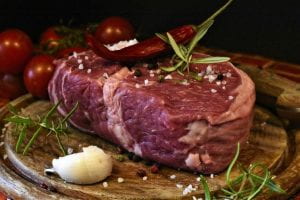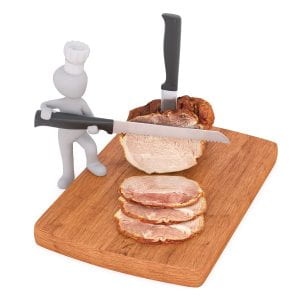
It’s likely that you have heard the phrases “eat like a lady” and “eat like a man”. What kinds of images come to mind when you think about each one? Do you think that a salad is meant for a lady or a man? Which gender fits the idea of eating a steak? With so many questions about two small phrases, let’s look more at the historical and gendered idea of food and feminism through an ecofeminism lens.
In Contextual Moral Vegetarianism, I appreciate how (the author) Curtin approaches the topic of vegetarianism in a wholistic way. In being a self-proclaimed “contextual moral vegetarian” they go on to say “Would I not kill an animal to provide food for my son if he were starving? Would I not generally prefer the death of a bear to the death of a loved one? I am sure I would” (Contextual Moral Vegetarianism, by Deane Curtin, n.d.). This is an important distinction in that one can choose to abstain from eating meat when there are other options available, and yet, when faced with no other options, do what is necessary to survive. I also appreciate how Curtin references different cultures and the respect that many have for the non-human animals that give their lives to sustain human life. I grew up in a family of hunters, and while I acknowledge there was an aspect of sport and domination, it was also done to stock the freezer with food to eat. There was an absolute respect for using all possible parts of the animal, which differs from the way that mass-produced nonhuman animals are raised purely for slaughter. This viewpoint connects to Curtin’s ecofeminism foundation in the way that all beings are connected. We can make conscious choices to refrain from eating other beings, and when faced with our own threat to survival, use non-human animals to sustain life in a revered and respected manner.
In Ecofeminism on the Wing: Perspectives in Human-Animal Relations, Greta Gaard looks at the human and animal connection through an ecofeminism lens of connectivity. In seeing a bird that is caged in less than ideal conditions, Gaard uses this example to show how humans dominate non-human animals, specifically in relationship to pets. She discusses how there is always one in power (the human) and one that is the oppressed (the pet) by the one in power. When looking at how pets are deprived of all their animalistic rights and are forced to depend on humans for everything that they need, she states that “if the situation were offered to humans, we’d call it slavery” (Gaard 2014, 21). From this veiwpoint, our relationship to non-human animals is one of imbalanced power, one where the humans decide how to exert power and force over the non-human animal. Through her example of the captive and mis-treated bird, Gaard, like Curtin, emphasizes the connection that all living things have to one another.
 Going back to the opening questions, there are numerous examples of gendered eating practices. One gendered eating practice is the idea of what women and men should eat. Instead of looking at diet as an individualized practice, the mainstream view is that women should eat less and should do so in a dainty and feminine-like manner. In contrast, men are encouraged to eat meat, consume larger portions, and do so with gusto and fervor. “But with meat still being the “manly” choice, it may become even harder for male consumers to opt for a meat-free lifestyle, even if they support it in theory. It’s hard to shift an individual’s perception without first tackling their society’s view” (Eisenberg, 2017). The antiquated stereotype that men need to eat meat in order to be masculine, is one that can only be shifted as we reshape the gendered norms around eating. Diet is an incredibly personal matter, and one that doesn’t need to be decided based on ones gender.
Going back to the opening questions, there are numerous examples of gendered eating practices. One gendered eating practice is the idea of what women and men should eat. Instead of looking at diet as an individualized practice, the mainstream view is that women should eat less and should do so in a dainty and feminine-like manner. In contrast, men are encouraged to eat meat, consume larger portions, and do so with gusto and fervor. “But with meat still being the “manly” choice, it may become even harder for male consumers to opt for a meat-free lifestyle, even if they support it in theory. It’s hard to shift an individual’s perception without first tackling their society’s view” (Eisenberg, 2017). The antiquated stereotype that men need to eat meat in order to be masculine, is one that can only be shifted as we reshape the gendered norms around eating. Diet is an incredibly personal matter, and one that doesn’t need to be decided based on ones gender.
Another gendered eating practice is when women should eat. My traditional grandmother always put love into home-cooked meals. She would make the meals, set the table, serve everyone at the table, and then make herself a small plate. She would either eat last, or nibble here and there so that she could continue to cater to the needs of everyone else who was mid-way through their meal. A similar practice is seen in cultures where women make food for men, who they have been told, need it for energy, or should be served first. In instances of food scarcity, it is women who will go without. Yet, it is the same women who will do the gathering of water, food, do the actual cooking, expend their energy, and then be expected to go without refueling themselves based on gendered norms.
 In taking a closer look to the image at the right, does anything stand out to you that might fit the above gendered and carnivorous observations? I see a version of the popular “Pillsbury Doughboy”. However, this person is gender neutral, not resembling either a man or a woman. The dough-person is carving up a slab of meat. There is not only a knife to cut the meat into slices, but there is another knife that acts as a stake going through the larger piece of meat. The image feels like a parody on the masculine association with killing nonhuman animals and eating them as carnivorous, wild (undomesticated) humans do. When discussing the many complex layers the comprise vegetarian ecofeminism, this image is a reminder that there are different ways of looking at things, not just a predicted, mainstream view.
In taking a closer look to the image at the right, does anything stand out to you that might fit the above gendered and carnivorous observations? I see a version of the popular “Pillsbury Doughboy”. However, this person is gender neutral, not resembling either a man or a woman. The dough-person is carving up a slab of meat. There is not only a knife to cut the meat into slices, but there is another knife that acts as a stake going through the larger piece of meat. The image feels like a parody on the masculine association with killing nonhuman animals and eating them as carnivorous, wild (undomesticated) humans do. When discussing the many complex layers the comprise vegetarian ecofeminism, this image is a reminder that there are different ways of looking at things, not just a predicted, mainstream view.
As stated in a previous post, ecofeminism is looked at comprehensively, not just its different, separate parts. In continuing to look at the interconnectedness of humans, non-human animals, and gendered food practices, we can strive to make better informed decisions and evaluate the effects our choices have on the world, as a whole.
Contextual Moral Vegetarianism, by Deane Curtin. (n.d.). http://www.animal-rights-library.com/texts-m/curtin01.htm
Eisenberg, Z. (2017, January 13). Meat Heads: New Study Focuses on How Meat Consumption Alters Men’s Self-Perceived Levels of Masculinity. HuffPost. https://www.huffpost.com/entry/meat-heads-new-study-focuses_b_8964048
Gaard, G. (2014, May 22). Ecofeminism on the Wing: Perspectives on Human-Animal Relations. https://www.academia.edu/2489929/Ecofeminism_on_the_Wing_Perspectives_on_Human_Animal_Relations

Christine you made a solid point about the amounts of food men are encouraged to consume vs. women. For one I can’t think of one diet that would encourage women to consume large amounts of food. If anything it’s the complete opposite. Women are usually pushed to do dieting that involves caloric deficit practices. While men who train to be bodybuilders bulk eat calories at certain periods of their training.
On another note, as I think about all of the gendered practices in food, I’m reminded of our non western ecofeminism week. I almost wonder if there are similar practices in the Global South? While I know you mentioned your grandmother as an example of gendered food practices, I believe generationally there are probably many similarities. But I think my questions about vegetarian ecofeminism now, come back to location.
Im reading this book by intersectional environmentalist Leah Thomas called, “ The Intersectional Environmentalist: How to Dismantle systems of oppression to protect people and planet” an in the chapter on ecofeminism Thomas says this about both ecofeminism and environmentalism, “ the treatment and degradation of the earth is underscored by societal problems. But ecofeminists focus primarily on how gender, sex, the patriarchy and gender roles negatively impact the environment” (Thomas, 32). Vegetarianism fits within these bounds because these gendered food practices socialize women into inferior places and spaces.
Works Cited Page
THOMAS, LEAH. Intersectional Environmentalist How to Dismantle Systems of Oppression to Protect People + Planet. SOUVENIR PRESS LTD, 2023.